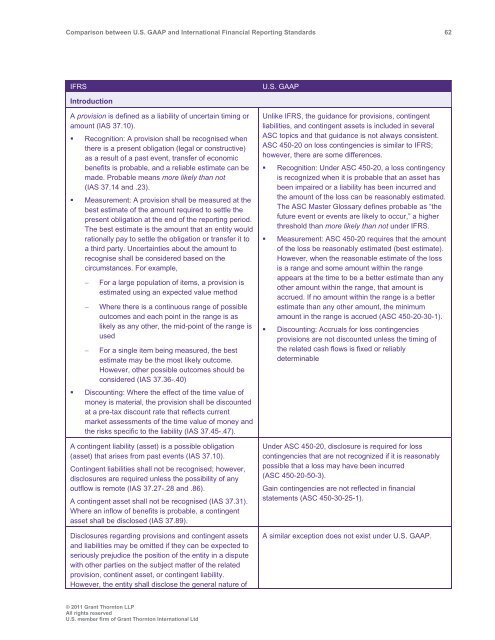Comparison between U.S. GAAP and International ... - Grant Thornton
Comparison between U.S. GAAP and International ... - Grant Thornton
Comparison between U.S. GAAP and International ... - Grant Thornton
You also want an ePaper? Increase the reach of your titles
YUMPU automatically turns print PDFs into web optimized ePapers that Google loves.
<strong>Comparison</strong> <strong>between</strong> U.S. <strong>GAAP</strong> <strong>and</strong> <strong>International</strong> Financial Reporting St<strong>and</strong>ards 62<br />
IFRS<br />
U.S. <strong>GAAP</strong><br />
Introduction<br />
A provision is defined as a liability of uncertain timing or<br />
amount (IAS 37.10).<br />
• Recognition: A provision shall be recognised when<br />
there is a present obligation (legal or constructive)<br />
as a result of a past event, transfer of economic<br />
benefits is probable, <strong>and</strong> a reliable estimate can be<br />
made. Probable means more likely than not<br />
(IAS 37.14 <strong>and</strong> .23).<br />
• Measurement: A provision shall be measured at the<br />
best estimate of the amount required to settle the<br />
present obligation at the end of the reporting period.<br />
The best estimate is the amount that an entity would<br />
rationally pay to settle the obligation or transfer it to<br />
a third party. Uncertainties about the amount to<br />
recognise shall be considered based on the<br />
circumstances. For example,<br />
<br />
<br />
For a large population of items, a provision is<br />
estimated using an expected value method<br />
Where there is a continuous range of possible<br />
outcomes <strong>and</strong> each point in the range is as<br />
likely as any other, the mid-point of the range is<br />
used<br />
For a single item being measured, the best<br />
estimate may be the most likely outcome.<br />
However, other possible outcomes should be<br />
considered (IAS 37.36-.40)<br />
• Discounting: Where the effect of the time value of<br />
money is material, the provision shall be discounted<br />
at a pre-tax discount rate that reflects current<br />
market assessments of the time value of money <strong>and</strong><br />
the risks specific to the liability (IAS 37.45-.47).<br />
A contingent liability (asset) is a possible obligation<br />
(asset) that arises from past events (IAS 37.10).<br />
Contingent liabilities shall not be recognised; however,<br />
disclosures are required unless the possibility of any<br />
outflow is remote (IAS 37.27-.28 <strong>and</strong> .86).<br />
A contingent asset shall not be recognised (IAS 37.31).<br />
Where an inflow of benefits is probable, a contingent<br />
asset shall be disclosed (IAS 37.89).<br />
Disclosures regarding provisions <strong>and</strong> contingent assets<br />
<strong>and</strong> liabilities may be omitted if they can be expected to<br />
seriously prejudice the position of the entity in a dispute<br />
with other parties on the subject matter of the related<br />
provision, continent asset, or contingent liability.<br />
However, the entity shall disclose the general nature of<br />
Unlike IFRS, the guidance for provisions, contingent<br />
liabilities, <strong>and</strong> contingent assets is included in several<br />
ASC topics <strong>and</strong> that guidance is not always consistent.<br />
ASC 450-20 on loss contingencies is similar to IFRS;<br />
however, there are some differences.<br />
• Recognition: Under ASC 450-20, a loss contingency<br />
is recognized when it is probable that an asset has<br />
been impaired or a liability has been incurred <strong>and</strong><br />
the amount of the loss can be reasonably estimated.<br />
The ASC Master Glossary defines probable as “the<br />
future event or events are likely to occur,” a higher<br />
threshold than more likely than not under IFRS.<br />
• Measurement: ASC 450-20 requires that the amount<br />
of the loss be reasonably estimated (best estimate).<br />
However, when the reasonable estimate of the loss<br />
is a range <strong>and</strong> some amount within the range<br />
appears at the time to be a better estimate than any<br />
other amount within the range, that amount is<br />
accrued. If no amount within the range is a better<br />
estimate than any other amount, the minimum<br />
amount in the range is accrued (ASC 450-20-30-1).<br />
• Discounting: Accruals for loss contingencies<br />
provisions are not discounted unless the timing of<br />
the related cash flows is fixed or reliably<br />
determinable<br />
Under ASC 450-20, disclosure is required for loss<br />
contingencies that are not recognized if it is reasonably<br />
possible that a loss may have been incurred<br />
(ASC 450-20-50-3).<br />
Gain contingencies are not reflected in financial<br />
statements (ASC 450-30-25-1).<br />
A similar exception does not exist under U.S. <strong>GAAP</strong>.<br />
© 2011 <strong>Grant</strong> <strong>Thornton</strong> LLP<br />
All rights reserved<br />
U.S. member firm of <strong>Grant</strong> <strong>Thornton</strong> <strong>International</strong> Ltd
















